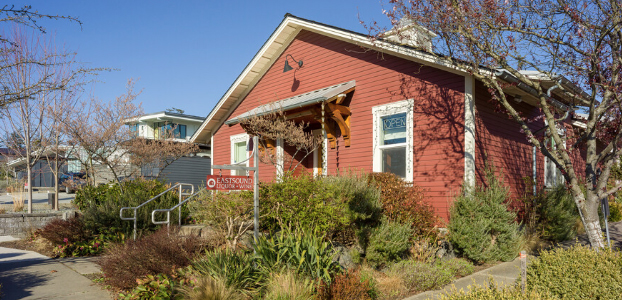— by Margie Doyle –
Rock Island Communications, an OPALCO company, has formed a strategic partnership with T-Mobile to provide LTE wireless services in San Juan County by sharing their collective infrastructure and expertise to the mutual benefit of each organization, according to Rock Island Executive Vice President Gerry Lawlor.
Each party has agreed to share their collective FCC spectrum leases (700MHz & 2100MHz). Rock Island has agreed to build and provide fiber connectivity at each location for data transport to the mainland. T-Mobile provides the technology and expertise to utilize the 700MHz spectrum which OPALCO acquired in November 2013 through a lease with the Federal Communications Commission (FCC).
As it happens, T-Mobile acquired the same spectrum leases through much of the nation soon after OPALCO purchased its spectrum for use by field crews and co-op members. The combination of spectrum allows for increased capacity while still enabling coverage throughout our hilly, wooded terrain. Rock Island will provide internet access for those for whom fiber is too costly to reach. “Our LTE Fixed Wireless product provides service in the 7Mbps to 20Mbps range depending on your exact location. This is far better than standard DSL to homes that may never be able to avail of the benefits of fiber due to cost,” Lawlor said.
“This partnership allows Rock Island to deliver more service to more people while allowing for complete access for all first responders and cell coverage throughout the county. Working together, we have both the technology and the expertise to achieve our priorities.” Customers are already receiving service in a variety of locations around the county and testing is ongoing with various first responder and county organizations.
“With T-Mobile’s expertise in engineering and design, we’ve reduced the number of pole locations needed from 120 to 38. The sites are camouflaged to blend into the surrounding area to make them as unobtrusive as possible.
“We have the network, they have far superior technology than we could obtain ourselves. Having an organization like T-Mobile step up and work with our small rural community like this is rare. The benefits will be far reaching for a long time to come,” said Lawlor.
He added that the agreement with T-Mobile is an exchange of services and no money was exchanged. While the agreement was made late last year, the build out is ongoing around the county.
**If you are reading theOrcasonian for free, thank your fellow islanders. If you would like to support theOrcasonian CLICK HERE to set your modestly-priced, voluntary subscription. Otherwise, no worries; we’re happy to share with you.**








So, OPALCO spends it’s money to build out all this infrastructure (paid for by the power members), and then hands over the keys to T-Mobile to run. This will never end badly….
Chris, not surprised that would be your reaction. Of course no keys have been handed to anyone. So it is clear for you, In-home fixed wireless customers, first responders etc using the network all remain Rock Island Customers and have nothing to do with T-Mobile and if someone is or becomes a cell customer of t-mobile they have nothing to do with rock island.
On the one hand, I like this development because OPALCO/Rock Island (I’m not sure which) is acting as a wholesaler dealing with a retail operation that has a lot more expertise in LTE technology as well as in dealing with customers who have other choices. On the other hand, I share Chris Sutton’s concern that T Mobile will not be paying anything for the privilege of using OPALCO funded infrastructure.
I am glad TMobile will utilize the fiber. I hope Verizon and ATT do also. As a former CTL tech I hold out hope that a deal might still happen with them to light up more of the CTL remotes as copper is still very viable for many users. I am a surprised, however, Tmobile is not paying for the privilege. When DBIUA went to OPALCO and asked to use the fiber for backhaul of our wireless network we were quoted a price of $90 per user on our system. That would mean we would currently be paying nearly $6,000 a month for a single connection to the fiber. If it was just about trading tech knowledge DBIUA has an internationally recognized success story for community wireless and have been contacted by communities as far away as India and Europe. We have no regrets on our decision to look elsewhere for backhaul as our monthly rates will be falling shortly for the early members and everyone else down the road. Maybe in the future OPALCO can look at giving good deals to local wireless technology based companies as well as the big companies. Now I guess I need to go back to TMobile for cell service.
I appreciate Orcas Issues reporting on OPALCO’s LTE investment. I am anxious for more information. In a document posted on OPALCO’s website (“Questions and Answers about OPALCO’s 700 MHz Frequency Purchase” – https://www.opalco.com/questions-and-answers-about-opalcos-700-mhz-frequency-purchase/2014/06/) I found several statements that would be nice to see come to fruition. The first “Once it (700Mhz LTE) is connected into our grid control backbone, our members will be able to connect wirelessly, thus utilizing our backbone for Internet connections at a far lower cost than connecting via fiber optics.”
Will LTE Wireless be available to all who can receive a signal or limited to those for whom fiber access is too costly?
The second statement in OPALCO’s 700mhz plan was “OPALCO will allow cell phone providers to access our infrastructure at the cost of service – like any other member – which could improve cell phone service.”
Given OPALCO’s $7.5M planned investment in building LTE coverage(from above noted document), I’d like to know what T-Mobile is bringing to the table that would justify its “no money exchanged” deal.
Can we get some more details on how this T-Mobile/OPALCO partnership is a win/win/win situation for us as rate payers as well as T-Mobile and OPALCO?
Margie, Tech reporting is no easy thing. Kudos to you on pointing out some of the subtle benefits of the 700 MHz spectrum in our wooded hilly terrain.
I have been a happy T-Mobile customer for many years. I noticed the Orcas coverage improving over the past few weeks. Also, I ran a speed test while on the ferry near Friday Harbor and got a stunning 98 mbps download speed. We seem to be getting state of the art systems.
Though I know OPALCO and Rock Island are aiming to improve wireless coverage and fill the communication blackholes around the county, and thereby improve personal and first responder communications, for those that lack wireless coverage, T-Mobile has a very nice feature called wi-fi calling that allows cell phones to work anywhere you have wi-fi. I use this feature when at home, with no wireless coverage. Verizon and AT&T have been playing catch up, and are planning, or may have finally started supporting that feature. It has been useful in our rural area.
Jay, Could you tell us if you have any affiliation with RI or OPALCO?
Thanks
Tom, You know full well he does.
Tom, I consult for the co-op on energy projects, including efficiency, community solar, load forecasting and energy assistance programs.
This “strategic partnership” between OPALCO/Rock Island and T-Mobile is, in concept, not unlike the negotiated “strategic partnership” between OPALCO and CenturyLink back in 2013. OPALCO walked away from that one, which would have provided improved Internet service to most of its members at virtually no cost to OPALCO, and instead chose to go into the broadband business on its own, at great cost to all OPALCO members, even though it will serve a fraction of what the “strategic partnership” with CenturyLink would have.
Curiously, in attempting to discount that analysis in an earlier post on orcasissues.com, OPALCO’s Public Relations Director, Suzanne Olson, called it a “fallacy,” said it “would have taken member-owned infrastructure out of co-op members’ hands and put it into the hands of an absentee corporation. Not good use of member resources.”
Now we have OPALCO/Rock Island putting member-owned infrastructure into the hands of an absentee corporation, and this time it’s good news. But unlike the CenturyLink deal, this time the absentee corporation has paid no money for the infrastructure.
OPALCO’s spin has gone well past dizzying. Rock Island has burned through most of what was to be three-years of start-up financing from OPALCO in its first year and failed to meet its modest first-year service goals. Members need to seek some accountability along with the spin. A good place to start would be for the Board to make public its contract with T-Mobile.
Alex: Thank you for your clarity. Amidst all of this “Spin” it is nice to hear someone who is grounded in Logic for a change!
Spirit Eagle
Deals that involve both complex technology and complex and time-variant financial implications attract criticism from those focusing on one or the other, though often claiming expertise in both areas. The OPALCO/T-Mobile LTE deal is a cooperating agreement involving equipment, spectrum and protocols between the two parties. Each seeks to further its own ends, for its own reason, and neither is required to disclose its ultimate aims or intentions to the other although geography and economics give each party an idea of the other’s intentions.
To date there are complaints that OPALCO shouldn’t have gone alone into the Internet business, but OPALCO can’t win: now it is criticized because it intends to share fiber and technology with T-Mobile. Criticism is unabated even though OPALCO gains in return needed 700MHz technology and expertise that T-Mobile already uses nationally, saving OPALCO/RIC duplication of effort at member expense. This results in an out-sized proportional benefit to OPALCO enabling its most efficient use of its spectrum. Those who don’t understand the value of the 700MHz spectrum should learn about it. Because of topography and (often wet) vegetation, it is particularly valuable in our county. Getting free 700MHz technology and operational protocols in connection with its use is worth a lot. What T-Mobile is offering OPALCO apparently can’t be matched by any other LTE provider. This makes arguments about what “should, could, would” have happened in the past involving other providers wholly irrelevant.
It’s pretty obvious that OPALCO is assembling something that will ultimately boost its members’ collective capacity for economic development. No, this is not going to be your parents’ fish, timber, construction, real estate, or tourism economy. We’re leaving Kansas. OPALCO/RIC’s fiber is the circulatory system for its members to be self-supporting, whether as remote employees, independent contractors, or sole businesses. If OPALCO/RIC’s sharing of fiber makes T-Mobile’s services faster or more efficient, should OPALCO members complain? This is not an issue of competition. It is an issue of a deal where both parties benefit. The fact that one party (preferably the other party of course) is not shown to suffer, does this have to create suspicion? Why?
My main problem with this whole issue is that OPALCO put it to the vote, of us the membership. We voted NO, and then the board went ahead and did it anyway. Why was there even a vote, they will never do that again! So now WE have to pay for a Public Relation Department, what’s with that?
It seems less and less of the money we pay for electricity to the non-profit electrical cooperative goes toward electricity.
Its a sad day when you cant believe a word that is said by someone you once loved and trusted.
OPALCO, think about that, you betrayed your lover and they are hurting. Why did you leave us and what did you leave us for? Where we just a stepping stone?
The above comment touches on the real issue here, one that OPALCO leadership and PR staff are remarkably (and consistently) tone deaf to- it’s not so much the outcome or ideas that OPALCO is so stubbornly pursuing (though I have my doubts), it’s that they (supposedly a cooperative and “democratic” institution) have ignored their members wishes at every step. They’ve adopted a paternalistic approach of simply patting us all on the head and saying “now now little utility customers, don’t worry, we know best and will take care of you.” All the while ignoring the wishes and concerns of their long time members and prioritizing the demands of a few well heeled and well connected “visionaries” who in reality are just looking for something to do with their newly retired egos and energy.
This latest T-Mobile news is just more of the same. Now, for those of us who don’t have the financial means to pay exorbitant hook up fees, the only way we’ll directly connect to this high priced infrastructure is by switching to a cell provider who has almost no footprint in the islands at the moment and who is looking for a toehold in the market. Outrageous.
You can measure the egregiousness of the travesty we’re witnessing by two things- 1.) The strident and almost desperate knee jerk responses to legitimate and informed dissent by OPALCO leaders and PR team (yes, we are paying for multiple PR staff), and 2.) the muttered discomfort and general unhappiness with current leadership by long time OPALCO staff. I guarantee if we put broadband to a vote of the entire OPALCO team and not just the self-selected board and high paid staff whose egos are so heavily tied to this, it would be voted down, strongly. And anyone with inside knowledge of the organization knows this to be true.
Look, no one wants to see OPALCO fail, we just want to see a more humble and responsive organization that truly listens to its members. And let’s not use scare tactics involving “emergency responders” or missing out on the new economy. Fact is that there are lots of ways to solve the broadband puzzle. Doe Bay’s efforts being a prime example. And let’s take a close look at where our schools, libraries, and local government are getting their connectivity from- in many cases it isn’t OPALCO- because OPALCO is expensive, not customer focused, and better options are available. Fact is that things aren’t half as dire on the broadband front as OPALCO supporters like to claim, and it’s only getting better.
I’m not sure what right approach is- I do want OPALCO to succeed but it might be time for a change of leadership at OPALCO- with hopes of bringing back a real (not just lip service) customer first approach.
Otherwise, I think we’ll see what’s happening here being added to a long list of examples of why when local power utilities leave their core business for broadband, things almost never work out well (truly, ask anyone in the power business outside of OPALCO leadership for an example of a rural power provider who successfully went into the broadband business).
I don’t know much about LTE. Don’t know much about Fibers. Know very little about backbones (other than mine hurts more as I get older) and very little about electrical services delivered through a co-op.
What I do know is that I can listen to those who work with their boots on the ground, and the story that I hear from management and the story that I hear from people with their hands in the mud are very different.
For OPALCO to say that resources we pay for with our electrical service money are not being used to allow Rock Island to function is a material untruth. Daily, we have linesmen, engineers and OPALCO resources which are being dispatched to jobs and projects around the islands to perform work which is as much as 90% related to internet service and 10% related to power. The time and wage for these workers is being charged against their OPALCO paychecks and accounted for as a charge to OPALCO for power related service.
This was perhaps one of my biggest concerns when this project started. How, are we going to properly separate the time and pay of a lineman – who needs to be present to turn on and off power while trench work and work around primary utilities – from the function that he/she provides specifically for the benefit of Rock Island? How do we effectively split the cost of the millions of dollars in Engineering costs that go into keeping our electrical system running out from the 1000’s of hours that they will spend “assisting” in implementing Rock island’s vision?
The answer – from those that I know with boots on the ground – is that we are not. Their time, their energy, and the resources we own are being charged as power related services but functioning for the internet build out. Do I have any charts, graphs or documented, smoking-gun proof? Nope… but I have ears, and I believe that listening to those working in the trenches is the best way to get a straight story. Why don’t we hear directly from them? Think about it… these people have jobs and families and I cant blame them for wanting to keep them!
I do not begrudge any entity for trying to improve internet service on the island. I was a Rock Island customer at one point in time, and thought they did a fine job. I think Orcas Online does a pretty fine job as well. What I don’t buy and am tired or hearing is the endless PR spin that Opalco keeps trying to feed us. Lets face it… this whole experiment is costing each member a whole lot more than $3 each and is likely to cost us a whole hell of a lot more as it rolls forward. I just wish we could get a straight answer instead of endless spin.
Now I know how a mushroom feels. Keep them in the dark and feed them XXXX.
Bill Appel said it best: “It’s pretty obvious that OPALCO is assembling something that will ultimately boost its members’ collective capacity for economic development.”
98 mbps download speed. Complete access for all first responders and cell coverage throughout the county.
Great job, Gerry Lawlor, keep it up; the naysayers don’t have a leg to stand on!
Well said Dan. As you are the owner of Wildlife Cycles and a member of the Chamber Of Commerce. . I’m sure you want to stanch the sniveling of seasonal visitors about reception and the roads in a rural county.
As Wally Gudgell said in a article in the sounder. You take people to multi-million properties on the waterfront, they don’t even get out of the car. They turn on their phones, no reception, no sale.
The people trying to survive are burdened by the “needs” of the people who have and can pursue their own agenda.
I will say again that the OPALCO Annual Meeting in barely three months hence needs to address the complexities of this internet issue. This discussion has been intensifying over the past year and represents a serious departure from the original “business” of OPALCO to provide electric power to the islands community. A “dog and pony show” at the Annual Meeting is not acceptable.
I suggest that the numerous members who are concerned about the internet/fiber-optics issue organize their thinking and be provided a significant period of time at the Annual Meeting to present their position on this issue.
I don’t believe that many people actually oppose the question of providing internet service. The issue is a) who provides it, and b) who pays for it, particularly the capital investment to extend the service. There is precious little information or communication that is understandable by most members. It is incumbent on OPALCO to be more forth-coming in better presenting this program.
Orcas Issues needs to do some serious follow-up reporting on this complex topic well in advance of the Annual Meeting.
Just a quick addition to my comments above. I re-read the Orcas Issues article and, frankly, have very little idea what Gerry Lawlor is talking about. The average islander doesn’t have a clue what a “700MHz spectrum” means, nor the relevance of “Fixed LTE Wireless Product with 20 Mbps”. WHAT ?????
The sad thing about all of this is that in most cases on the islands, “high speed” internet is not needed but instead.reliable, consistent internet. Much to the surprise of many island residents there is an alternative available now that is currently being utilized by over 200 San Juan County residents from all locations in and around San Juan Island as well as Lopez, Shaw, and Orcas Islands. It Satellite Broadband Service. Although this service requires an additional dish in order to get reception, The installation is free and the Retailer/dealer is local. The service is reliable and with speeds of up to 25mbps or more as well as the introduction of the new “LIBERTY PLANS” customers are no longer without internet services if they exhuast their priority data amount .
Which means that the majority of people on all of the islands can enjoy high speed service right now and at a price that’s affordable and flexible to your needs.
I would ask that anyone who has this service please respond to this posting with your thoughts and experiences.it would go a long way in answering questions about the service.
Justin…thanks for contributing an important aspect to our community conversation about this critical issue.
If what you report is true, I can’t help but wonder why such a fundemental piece of information for running a business…i.e., categorizing expenses to reflect what’s really happening in the field…is not being gathered and maintained.
Last I heard, better information leads to better decisions.
I personally am just excited by the news. In the near future our currently cell phone access-less house on Lopez connected to the uncaring giant CenturyLink’s expensive and low grade internet may move into the same league as my winter home in a tiny Mexican town where the internet is fast and cell service universal. Wow Lopez may make it into the 21st century with all the communications excellence, energy saving and job creation current and future technologies have to offer. You all can fight over your personal pet peaves; I’m only glad that OPALCO has had the wisdom to have more vision and interest in the utility services a 21st century community will need.
Fred,
If, the charges are being properly accounted for the labor division on the part of OPALCO crew workers, then it should be easy to figure out.
We should see a regular and comprehensive bill from OPALCO to Rock Island for all equipment, labor and materials that are being used by OPALCO to support the rock island install. It should be easy for Opalco to provide the line item accounting of revenue received from RI to compensate our membership for the services that the Coop provided to the separate entity. I’m not sure what the policy is for the disclosure of such information, but I’m sure someone here does.
How soon can we see a coverage map for both Rock Island fixed wireless as well as T-mobile cellular service?
Justin: the Rock Island construction effort is tracked by a work order system. Rock Island work orders are separate from OPALCO work orders – they are tracked and tied to completely separate entities – one taxable and one not – black and white. You are welcome to come in and talk with us if you want a deeper understanding of our work order system.
Suzanne,
If I understand what you are saying correctly then, when an OPALCO linesman goes out to provide support for Rock Island work then the time and resources is paid through out of a work order generated by who? And from who’s account does the payment to cover those resources come from.
I.e. Are the OPALCO linesmen and engineering staff hours being paid by Opalco, or Rock Island? If by OPALCO, how is the renumeration back to the cooperatives financials settled to assure that no hours are in essence “donated” to the Rock Island effort?
Or, is it OPALCOs position that engineering and lineworkers are not taking part of the Rock Island effort and therefore there is no cross-tracking necessary?
Thanks!
Justin – Rock Island work is paid for by Rock Island and ALL of our work orders are audited to make sure all work efforts (labor and materials) are being billed with correct coding to the right project and entity. For more info than that, come in and talk with someone who can explain the process in more detail than I can.